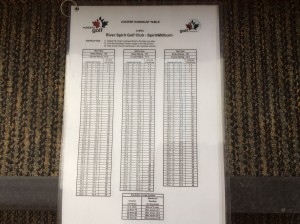How much do you know about the golf course you are going to play, or have just finished playing? Did you check your handicap for this course before you started playing? Do you even know how to find your handicap for this course? Depending on where you live, you have either a factor or an index…do you know how these are calculated? Do you post your score to establish your factor or index? Do you know why slope and rating are important?
All these things should be important to you as a golfer.
Slope and Rating
At the crux of slope and rating is a brilliant idea that is an extension of the idea of handicap, which lets players of different levels compete against each other equally, with adjustments for skill. Slope and Rating takes this idea one step further, making each course equal for every player, adjusting their handicap for the ease or difficulty of a particular track.
The course’s Rating is the evaluation of the playing difficulty of a course for scratch golfers under normal conditions and weather conditions. The rating is expressed as a number of strokes.
The Slope is the evaluation of the relative difficulty of a course for players who are not scratch golfers compared to the difficulty of the course for scratch golfers. The lowest Slope rating is 55 and the highest is 155. A course of standard playing difficulty will have a Slope rating of 113.

River Spirit Golf Course – Rating and Slope for men and ladies for each sets of tees. As there are 27 holes, the chart shows the combination of nines that make up the rotation for 18 hole play.
USGA and Golf Canada
Golf Canada is the governing body for golf in Canada and in the USA, the governing body is the USGA. The provincial organizations in Canada and the state organizations in the USA are responsible for determining the rating and slope for all the golf courses in their jurisdictions. In Canada this is called a “Handicap Factor” and in the USA, it is called a “Handicap Index”, but no matter what they’re called, the resulting calculations are identical. And that’s no coincidence because Golf Canada adopted the Course and Slope Rating System that was developed by the USGA.
Every golf club that belongs to the state or provincial organization will have a Course Rating and Slope Rating for each set of tees on the course for both male and female players – and those ratings are usually displayed right on the card. Then for your handicap, the charts of Course Ratings and Slope Rating must be easily accessible to all players, and that is where you look up your factor / index to find your handicap for that particular course.
The Factor or Index issued by a golf club or authorized golf association (through its member clubs) indicates a player’s skill and is a number to one decimal place. e.g., 17.2 or 17.1 If I scored 90 at River Spirit playing Spirit/Millburn from the red tees the calculation for posting my score would be: 90-70.5 x 113/128 = 17.2. If I scored 90 playing Cattails/Spirit the calculation would be: 90-71.1 x 113/125 = 17.1. You can see the different ratings and slopes for the above courses. Generally speaking the higher the slope the tougher the course.
A player posts scores along with the appropriate golf Canada or USGA Course Rating and Slope Rating to make up the scoring record. The Factor or Index is computed from no more than 20 scores plus any eligible tournament scores. It reflects the player’s potential as it is based upon the best scores posted for a given number of rounds. ideally the best 10 out of the last 20 rounds of golf.
Most clubs have computerized handicap systems for members to post their scores. However you must take into consideration ESC as shown below before posting your score. For me I have a maximum of 7 on any hole so if I scored 90 with an 8 on one hole I must take 1 off my score before posting. I would post 89.
ESC stands for Equitable Stroke Control. It is the downward adjustment of individual hole scores for handicap purposes in order to make handicap factors or indexes more representative of a player’s potential ability. The ESC sets a maximum number that a player can post on any hole depending on the player’s Course Handicap. This is used only when a player’s actual or most likely score exceeds his maximum number.
Course Handicap Maximum Score
9 or less – Double Bogey
10-19 – Maximum 7
20-29 – Maximum 8
30-39 – Maximum 9
40 and over Maximum 10
Provincial and State associations conduct series of handicap seminars and new golfers should attend one of these seminars so they can understand what their handicap is all about.
Both Golf Canada and the USGA rate new courses after they first open, and again within five years. Established courses are rated every ten years, or if major changes have been made to the course, like making modifications to a hole, lengthening the course, adding hazzards.
When I get to a golf course, one of the first things I do after checking in at the Pro Shop is go and check my handicap. You can usually find these hanging on bulletin boards in an obvious place, but if you can’t find it, ask for help from the Pro Shop.

